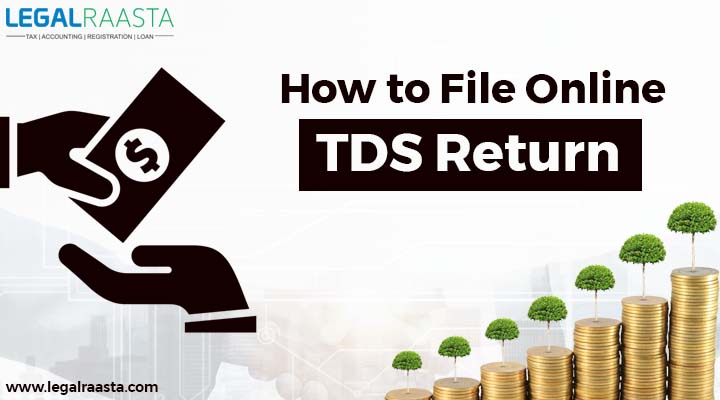What is TDS? Steps to file TDS Return online
TDS: What is it?
TDS is short for "Tax Deducted at Source". As the name suggests, TDS has been introduced to collect tax at the source from which an individual's income is generated. The provision of TDS was introduced to put a curb to tax evasion measures being taken by fraudulent individuals. This is done by taxing the income (wholly or partially ) at the time of generation of said income rather than setting up a later date which might encourage people to start evading their taxes. In this article, we're going to see what it means and steps to file it's returns online.
The TDS taxation system in India is regulated by the Income Tax Act. It can be applied on a wide range of incomes generated including salaries, interests, and commissions received by individuals. However, not every generated income or commissions are liable to be taxed under it. The tax has been divided into different rates depending upon the types of payment and their intended recipients. Let's take an example: The redemption proceeds payment by a debt mutual fund is not taxable if the recipient is a resident individual. However, if the recipient is a foreign national/non-resident, the same payment is taxable under TDS rules.
Here are some of the sources eligible for TDS- Salary Payment
- Incomes generated through securities
- Remuneration received for Winning
How TDS works
The concept for TDS is very straightforward, every person making payments of specified types to any other individual is responsible for deducting taxes at the rates which have been prescribed by the Income Tax Act. The person responsible for deduction is also responsible for submitting the taxes collected by the government. This person is labeled as the 'deductor'.
Contrary to this, the person who receives a payment which has been subject to deduction under it is called a 'deductee'. The taxes deducted at the source from a particular individuals income are registered against their name/PAN in a statement also known as Form 26AS. The form 26AS, therefore, can be viewed to keep track of it, deducted from incomes received.
Deductors have to shoulder the responsibility of issuing a TDS certificate and filing it with the government indicating the amount deducted in the deductee's name. Deductees should also receive a certificate stating the amount of it and they can claim the same TDS amount as the tax paid by them for that particular financial year. In most cases, it ranges from 1 percent and 10 percent
Tax Rates Under TDS
It is not just a percentage based tax which is levied equally on every individual. The amount of tax deducted for a particular person depends on the type of transaction as well on the type of recipient. Here we provide you with a list of rates for different kinds of payments.
| Payment/ Income Type | Section of TDS Applicable | TDS Rate(Rate of Deduction) |
|---|---|---|
| Salaries | Section 192 | Applicable Income Tax Rates inclusive of cess |
| Accumulated Taxable part of PF | Section 192A | 10% |
| Deemed Dividend | Section 194 | 10% |
| Interest on Securities | Section 193 | 10% |
| Other Interests(Excluding securities) | Section 194A | 10% |
| Winnings from Lotteries or any other kind of game | Section 194B | 30% |
| Winnings from Horse Races | Section 194BB | 30% |
| Insurance Commission | Section 194D | 5% |
| Life Insurance Policies (Section 10 (10)D exempts few Policies) | Section 194DA | 1% if payments exceed Rs. 1lakh in Financial Year |
| Commission or brokerage except for Insurance commission | Section 194H | 5% if payments made exceed Rs. 15000 in the Financial Year |
| Payment made for land or property | Section 194IA | 1% |
| Rent Payment by individuals or HUF in excess of 50% | Section 194IB | 5% |
TDS Applicability
It is a tax which is deducted from incomes only if they cross a certain threshold level which has been specified according to the rules. Recipients should vary that nobody should deduct TDS from their income if the value of the income is not crossing that specified level. Threshold levels for different types of incomes/payments made to individuals are different and the Income Tax Department regulates and decides these tax deduction rates. Example: No TDS on interests received from FD/FDs of a single bank if the amount of interests received does not cross the Rs. 10,000 mark.
Avoiding TDS
If an individual expects that they will not have a total income beyond the exemption limit in a financial year, they can ask payers not to deduct it with the help of Forms 15G/15H.
If the income is being taxed under it's rules, it is advisable for individuals to provide their PAN details so that they don't have to endure taxation at higher rates.
TDS Returns: What are they?
TDS return is nothing but quarterly statements to be submitted to the Income-Tax department containing following details.- PAN of the deductor and the deductee
- Challan Information of it
- Amount of Tax paid to the government
| Quarter | Quarter Time Frame | Due Date TDS Return |
|---|---|---|
| 1st Quarter | April 1 - June 30 | 31st August |
| 2nd Quarter | July 1 - September 30 | 31st October |
| 3rd Quarter | October 1 - December 31 | 31st January 2019 |
| 4th Quarter | January 1 - March 31 | 31st May 2019 |
TDS Return Procedure(e-TDS)
Organizations or employers with appropriate TAN should file TDS returns as soon as possible. If an organization fails to file TDS returns within 1 year of the due date, they could be fined up to Rs 1 lakh in some cases. Thus, it is important to file these returnsTDS Return Forms
Following are the particulars of forms needed for filing returns.| Details | Form |
|---|---|
| Salary TDS | Form 24Q |
| Cases where TDS deductee is non-resident, Foreign company | Form 27Q |
| TDS on Payments made for the transfer of immovable property | Form 26 QB |
| All other cases | Form 26Q |
- Add deductor(s)
- Add and verify Challan Payments
- Include all the employees/deductees
- Match up the challans with the deductees
- Verify Returns and generate FVU










